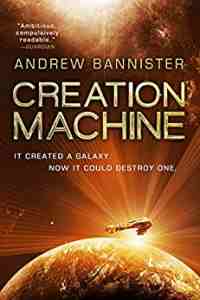Creation Machine by Andrew Bannister
 Friday, March 22, 2019 at 9:11AM
Friday, March 22, 2019 at 9:11AM 
First published in the UK in 2016; published by Tor Books on March 5, 2019
Creation Machine takes world-building to the level of galaxy-building. The Spin consists of 89 artificial worlds and a number of artificial suns that seem to have been created as a joke. As is true of all good galaxies, the fun planets are fairly lawless while the boring planets are tightly controlled. Taussich is among the planets of the Cordern, the six innermost planets at the center of the Spin. Taussich has established a five-planet protectorate controlled by the Patriarch, whose advisor/enforcer (because every dictator needs a Darth Vader) is Alameche, a sadistic and Machiavellian Head of Security who does most of the Patriarch’s thinking and all of his killing.
Taussich would like to have a greater role in the Hegemony, which dominates the worlds of the Inner Spin. The Hegemony is repressive — it doesn’t like artificial beings or artificially enhanced humans, nor is it tolerant of free thought. Its rigidity has not yet spread to Catastrophe (where a couple of planets once collided, creating from rubble the Catastrophe Curve) although it is expanding its reach to the Outer Spin.
Taussich all but destroyed the protectorate’s fifth planet in order to bring it within its protective fold. Certain powerful interests took notice but decided to leave the barbarians alone until they learned that Taussich discovered an artifact on the planet it most recently plundered. The artifact may be an apocalyptic weapon, although the humans on Taussich have no clue what it is. A mechanistic representative of the powerful interests, Machiavellian in its own right, comes to Taussich to assert dominion over the artifact.
A good bit of work and imagination went into the novel’s background. I’ve only described the basics, but there are enough planets and aliens here to power a television series for several seasons. Of course, a novel needs plot and characters in addition to ideas and atmosphere, something certain sf writers tend to forget. Fortunately, Andrew Bannister delivers an entertaining story with a nice mix of likable and despicable characters.
Fleare Haas begins the novel as a prisoner, one of the few survivors of a group that challenged the Hegemony. Fleare’s father is a rich bastard who has a powerful position in the Hegemony. Fleare rebelled against her evil father — hence her imprisonment. Fortunately, Fleare’s former lover Muz is still alive. Perhaps less fortunately, Muz now exists as a cloud of nano-machines. He’s handy in a fight, but maybe not a girl’s dream date.
There are plenty of fights and chases and adventures as Fleare reconnects with a couple more members of the old rebel group on an anarchistic planet, then tries to stay free and alive. Eventually the story shifts away from Fleare and refocuses on Alameche’s scheming.
During the late chapters that take place on Taussich, we learn something about the nature of the artifact. Not coincidentally, we also learn something about why the novel is titled Creation Machine. There is clearly more to learn, and the path to discovery will presumably extend into the rest of Bannister’s Spin Trilogy. Those have been published in the UK and I’m guessing Tor will soon market them in the US.
As the first novel in a trilogy, the story doesn’t really end, although a few of the characters do. Some of the dangling threads are perplexing, as is the nature of one of its surviving characters. The novel avoids a cliffhanger but the reader will need to move on to the next book as the first one cannot be read as a self-contained story. I don’t mind doing that because it would be a shame to waste all that galaxy building on a single novel.
The story’s political intrigue is fairly standard for science fiction (or world history texts, for that matter) but the greater intrigue lies in the artifact. We get only a glimmer of its nature and purpose, enough of a teaser to invite interest in a full development of the concept. Given the Bannister’s fluid writing style and his ability to integrate detailed story elements with fast-paced action, I look forward to seeing what happens next.
RECOMMENDED
Reader Comments